Dramatic three-dimensional work from six talented sculptors
This story was featured in the July 2018 issue of Southwest Art magazine. Get the Southwest Art July 2018 print issue or digital download now–then subscribe to Southwest Art and never miss another story.
Jason Napier
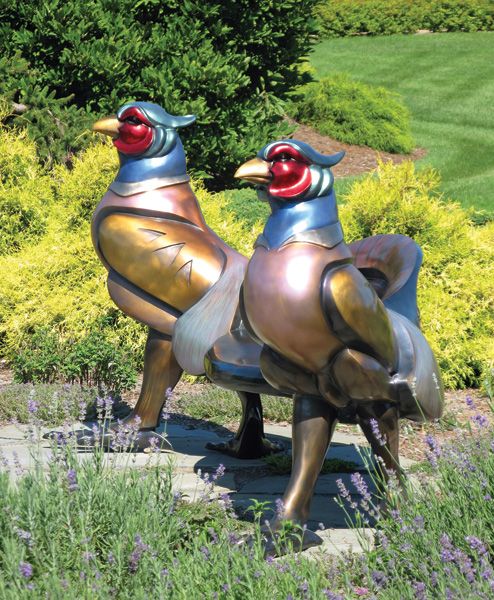
Jason Napier, Two Tales, bronze, 4 x 8 feet.
Jason Napier’s colorful sculptures of animals seem universal yet familiar. The personal details are missing, but the warm patinas and smooth curves of the bronze give each one a personality of its own. Napier had always felt a special connection to the animals he grew up with on his parents’ farm. “It seemed natural to start sculpting wildlife and give my own personal attention and details to it,” Napier says.
While he had watched many sculptors work, the artist’s background was in patinas. He spent several years experimenting with the oxidizing chemicals to develop unique colors. When he first began sculpting, he included small details in his works, but he found that the patinas did not show up the way he anticipated. He then focused on simpler shapes, using patinas to imply the details he left behind. “I like sculptures to be easy to read and to flow well but still have that whimsical nature,” Napier says. “I like combining the technical processes with the organic movement of the animal.”
Napier hopes the stylized nature of his work facilitates deeper connections with viewers. “It’s all about finding something in the animal that catches you,” he says. “I hope that whoever sees it will remember it when they go home and keep it living with them, even if they don’t buy the sculpture.” Napier’s work can be seen at The Signature Gallery, Santa Fe, NM; Mountain Trails Gallery, Jackson, WY, and Park City, UT; Desert Mountain Fine Art, Scottsdale, AZ; and www.jasonnapier.com. —Mackenzie McCreary
Joe Cajero
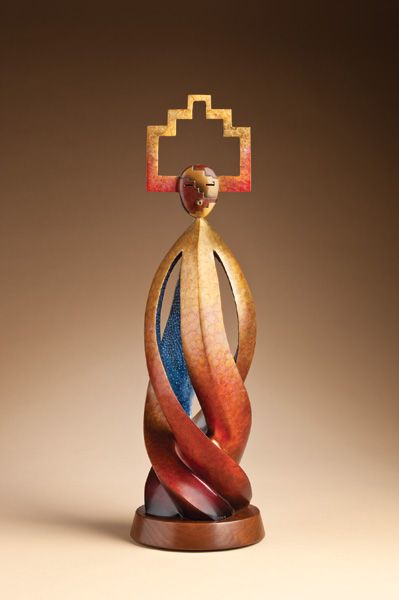
Joe Cajero, Oneness, bronze, 26 x 9 x 9.
Joe Cajero’s bronze depictions of animals, figures, and abstracted forms fuse art and spirituality together on both a profoundly personal and an exceptionally universal level. Cajero’s childhood in the Jemez Pueblo was steeped in the ceremonial traditions, religion, and language of his people. Today, working in nearby Placitas, NM, his heritage frequently manifests itself in his sculptural creations, which range in style from realism to contemporary abstraction and vary in size from tabletop to monumental.
Recently, a monumental version of one of Cajero’s abstracted sculptures, titled ONENESS, was installed in the rotunda of Hotel Chaco in Albuquerque, NM. Brimming with spiritual symbolism from head to toe, the 9-by-3-foot figure is crowned with a headdress sculpted in the shape of a kiva altar step. But other aspects of the sculpture, such as its multihued patinas and four central swirls, were designed to carry universal meaning. “I wanted to portray a spiritual energy that anybody can tap into and believe,” says Cajero of the piece.
Indeed, the sculptor’s works reflect archetypal facets of the human journey to which people of all faiths, cultures, and life experiences can relate. Caterpillars and butterflies, corn maidens and water, negative space and numeric patterns have all played a purposeful role in Cajero’s sculptures. “As elements in life ring of truth to me, and I infuse these elements into my work, may they also ring true for someone else, somewhere else, who is also engaged in questions about life and spirituality,” he says. Find Cajero’s work at True West Gallery, Santa Fe, NM; Gallery Chaco, Albuquerque, NM; Wright’s Indian Art, Albuquerque, NM; and www.cajerofineart.com. —Kim Agricola
Angela Mia De la Vega
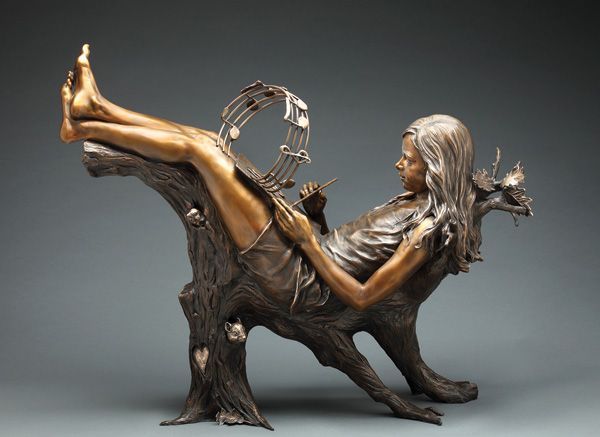
Angela Mia De la Vega, Painting Music, bronze, 40 x 53 x 17.
Outside of her childhood home there was a tall pine tree with a wide trunk. One day, Angela Mia De la Vega’s mother decided to carve into the tree, hollowing out a small room where she placed a table and a few chairs. Her mother turned to her and said, “This is your studio.” That was an important moment for the budding artist. “I would go there and create these little clay monsters and fairies,” De la Vega says. “It was an important outlet of expression for me, and having my parents support me in that way was wonderful.”
De la Vega’s love for sculpture led her to study classical, representational art. She finds inspiration in the people who surround her, especially her own children. “It’s helpful if I can fall in love with my model before I sculpt,” she says. “It helps me to bring out their inner beauty as best I can through their outer beauty.” Today her whimsical sculptures of children hearken back to the days spent in her tree studio. “Seeing all of these different children with their unique characters and personalities always fascinated me,” she says. “It allows me wonderful access to my own inner child as well.”
The most important part of the artist’s process is being honest in her work. “When I have expressed myself deeply from the heart, and I see someone else interact with it, we bond over this communication of our stories of the sculpture,” she says. De la Vega’s work can be found at Gallery 901, Santa Fe, NM; Mockingbird Gallery, Bend, OR; T.H. Brennen Fine Art, Scottsdale, AZ; Wyland Galleries, South Lake Tahoe, CA, and Honolulu, HI; and www.delavegastudios.com. —Mackenzie McCreary
Darrell Davis
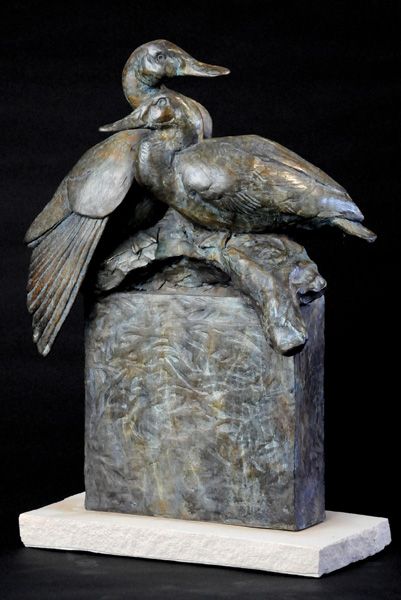
Darrell Davis, La Paire d’Amour, bronze, 25 x 16 x 10.
In the summer of 1977, 14-year-old Darrell Davis settled upon his vocation in life. The Texas native was on a road trip with his church’s youth group to see, among other sites along the way, the impressive collection of life-size sculptures at Brookgreen Gardens in South Carolina. “I was in la-la land,” Davis says of the momentous visit. “Every moment since then I was trying to find out how to sculpt.”
Fast-forward to 2013, when the now professional sculptor stood in the gardens once again, this time for the prestigious National Sculpture Society’s 80th annual exhibition, where he garnered the gold medal for his bronze sculpture LA PAIRe D’AMOUR. The portrayal of two nuzzling ducks atop driftwood typifies Davis’ talent for capturing wildlife authentically with an imaginative touch. Periodically, the architecture buff also incorporates man-made structures in his sculptures as he explores the interaction of wildlife and the human world. “I’ve always imagined my pieces as very large installations in the middle of a modern city,” says Davis, who studied both fine art and landscape architecture in college. “So, if you turned a corner and saw these giant displays of nature, it’s just a reminder that, hey, we’re here, too—the cat, the falcon, the wolf. It’s something I think we innately miss in our world today.”
The Arlington, TX, sculptor is often inspired by scenes in nature he himself has observed, from the eventual parting of a doe and her maturing fawn to a gathering of great blue herons along a coastal lagoon in South Texas. Find his work at Anglin Smith Fine Art, Charleston, SC; Columbine Gallery, Loveland, CO; Manitou Galleries, Santa Fe, NM; Shaw Gallery, Naples, FL; and www.davisbronze.com—Kim Agricola
Adam L. Wiedmann
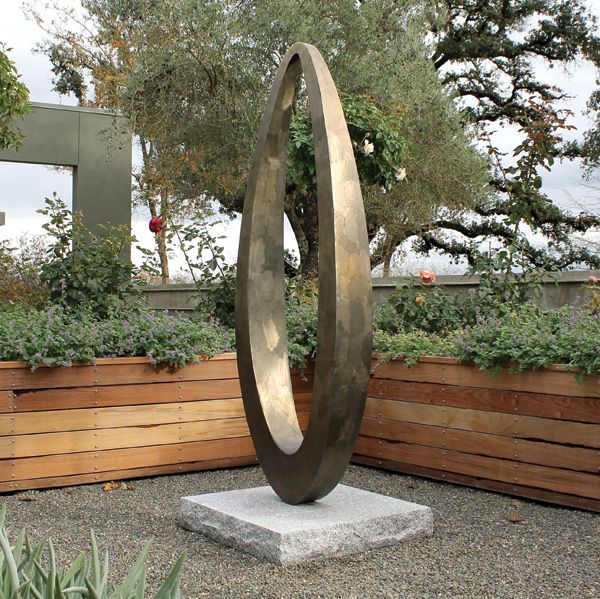
Adam L. Wiedmann, Untitled, 2015, stainless steel, 68 x 24 x 24.
“I love loud, exciting things that have a hint of danger,” says sculptor Adam L. Wiedmann. “But really I’m like a kid playing with big metal blocks.” Many of Wiedmann’s stainless-steel sculptures are massive—seemingly solid and heavy, yet suggesting something more light and fluid with their sense of movement.
Wiedmann began his journey in sculpture when he “faked his way” into a job with another sculptor in his studio. After interest in his own work grew, he struggled with the major question of being an artist: purpose. “I realized that what [artists] give [to viewers] is a spiritual experience where people find their relation to the work through their history of living in the world,” Wiedmann says.
The artist chose stainless steel as a medium because of his excitement about the process of working with the metal, as well as the different things it allowed him to do. “It slows me down and keeps me from going too wild,” he says. The medium also allowed him to create large-scale pieces. “Once you go to 6 feet or taller, it’s so powerful, and it demands its own space,” he says.
Wiedmann finds inspiration in the lines and shapes of everyday life, but he doesn’t seek to recreate what he sees. “Those various lines trickle out, but the sculpture isn’t supposed to be anything else,” he says. “And if I put a title on it, then I’m telling people what they should see. What they see is up to them—I’m just the vehicle to their experience.” Wiedmann’s work can be seen at Gruen Galleries, Chicago, IL; Aerena Galleries and Gardens, St. Helena, CA; and www.hammerswinger.com. —Mackenzie McCreary
Kristine Taylor
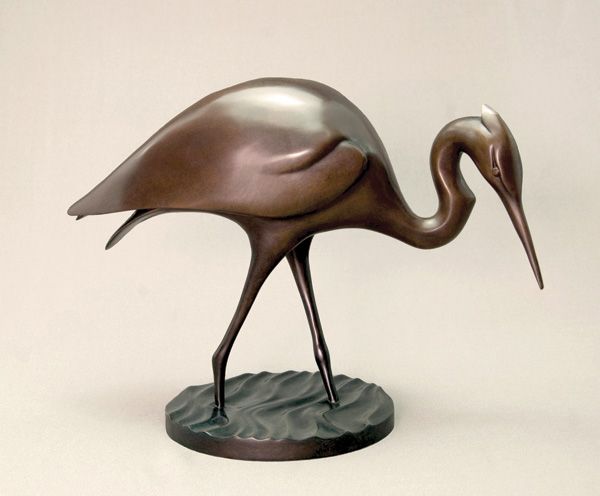
Kristine Taylor, Wading for Dinner, bronze, 10 x 14 x 7.
When looking at one of Kristine Taylor’s works, the eye follows the gliding lines along the edges of the body, the wings, the neck, or the feathers. “When sculpting an animal, I try to capture a pose that highlights the animal’s personality,” Taylor says. “It’s a subtle gesture that reveals the essence of the creature.”
Taylor grew up in a rural area where she was surrounded by animals of all kinds. After graduating from Stanford University, she began experimenting with resins to make small sculptures. But the medium limited her in terms of size and shape. Soon she started working with self-hardening epoxy clay and eventually cast those works in bronze. “With this type of sculpting I can focus on what appealed to me about the animal—the way they express themselves—through shape and line rather than detail and color,” she says.
Taylor uses photographs and digital images to help develop her subjects. “I spend a lot of time doodling on bits of paper just to catch an interesting shape that speaks to me,” she says. Her stylized sculptures omit specific details and utilize negative space. Taylor says she often includes those details in the clay initially but grinds them off before casting. “I want the shape to come through more than my skill of anatomy or textures,” she says. “I don’t want to capture my techniques as an artist, but the animal on its own, whether it’s powerful or anxious, the predator or the prey.” Taylor’s work can be seen at Nancy Dodds Gallery, Carmel, CA; Tartaglia Fine Art, Ojai, CA; The Studio Shop, Burlingame, CA; and www.ktaylorcreations.com. —Mackenzie McCreary
This story was featured in the July 2018 issue of Southwest Art magazine. Get the Southwest Art July 2018 print issue or digital download now–then subscribe to Southwest Art and never miss another story.
MORE RESOURCES FOR ART COLLECTORS & ENTHUSIASTS
• Subscribe to Southwest Art magazine
• Learn how to paint & how to draw with downloads, books, videos & more from North Light Shop
• Sign up for your Southwest Art email newsletter & download a FREE ebook





